 [an error occurred while processing this directive]
[an error occurred while processing this directive]
Video cards with 128 MBytes memory
[an error occurred while processing this directive] [an error occurred while processing this directive]
[an error occurred while processing this directive]
RAM remains one of the cheapest basic components in a system block. Today's operating systems require at least 256 MBytes of fast RAM. But does it make sense to install a lot of memory on video cards? It depends as video cards of the gaming class can differ considerably in power and capabilities. Of course, 3D applications take a lot of memory (for 2D 4-8 MBytes is enough). As you know, texturing, frame-buffer, Z-buffer etc. require a large RAM on a video card. One the one hand, there is an AGP, that is why a too big texture array can be put into the main memory of the computer; however, a not too rapid AGP often limits the overall performance of the accelerator. That is why 32 MBytes of memory should be provided for modern games.
Our tests show that a lot of tough games have such great size of textures that a 64 MBytes card is able to perform much better than a 32 MBytes card. Such memory excellently go with expensive accelerators (GeForce3, RADEON 8500), however it is also often installed on low-end cards (GeForce2 MX200, MX400) with the advertising purposes, where such memory is unnecessary as a bottleneck here is not a size but a memory bandwidth.
Well, less but faster memory is better than more but slower one.
And now we will digress from raising of memory volumes on video cards and look at how it is possible to make out of the RADEON 7500 something average between the old and the new product.
Joytech Apollo RADEON 7500 SDR
Unsatisfied with a usual RADEON 7500 Joytech decided to make a lighter version so that it can belong to a lower price niche.
First there were two such cards: with 64 MBytes and 128 MBytes of RAM. As the name indicates the memory is of the SDR type although originally the RADEON 7500 was designed for DDR memory.
Let's take a look at both versions.
Joytech Apollo RADEON 7500 64 MBytes SDR
The Joytech Apollo RADEON 7500 64 MBytes SDR has an AGP x2/x4 interface, 64 MBytes SDR SDRAM located in 8 chips on the right and back sides of the PCB.
[an error occurred while processing this directive] [an error occurred while processing this directive]
[an error occurred while processing this directive]
[an error occurred while processing this directive] [an error occurred while processing this directive]
[an error occurred while processing this directive]
[an error occurred while processing this directive]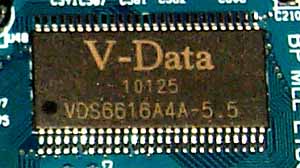 [an error occurred while processing this directive]
[an error occurred while processing this directive]
V-Data produces memory chips with 5.5 ns access time which corresponds to 183 MHz. But the memory works at 166 MHz. As you can see, the developers used a very cheap memory which couldn't even run at its rated frequency (as the overclocking showed).
Joytech Apollo RADEON 7500 128 MBytes SDR
The Joytech Apollo RADEON 7500 128 MBytes SDR has an AGP x2/x4 interface, 128 MBytes SDR SDRAM located in 8 chips on the right and back sides of the PCB.
[an error occurred while processing this directive] [an error occurred while processing this directive]
[an error occurred while processing this directive]
[an error occurred while processing this directive] [an error occurred while processing this directive]
[an error occurred while processing this directive]
[an error occurred while processing this directive] [an error occurred while processing this directive]
[an error occurred while processing this directive]
M-Plus produces memory chips with 6 ns access time which corresponds to 166 MHz. And the memory works at this frequency. The memory is again cheap and doesn't overclock at all.
As you can see, both cards look like twins and differ only in the memory size:
Joytech Apollo RADEON 7500 64 MBytes SDR
[an error occurred while processing this directive] [an error occurred while processing this directive]
[an error occurred while processing this directive]
[an error occurred while processing this directive] [an error occurred while processing this directive]
[an error occurred while processing this directive]
Joytech Apollo RADEON 7500 128 MBytes SDR
[an error occurred while processing this directive] [an error occurred while processing this directive]
[an error occurred while processing this directive]
[an error occurred while processing this directive] [an error occurred while processing this directive]
[an error occurred while processing this directive]
ATI RADEON 7500 64 MBytes DDR
[an error occurred while processing this directive]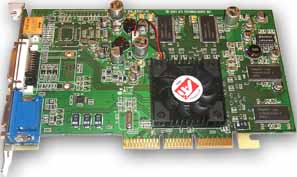 [an error occurred while processing this directive]
[an error occurred while processing this directive]
[an error occurred while processing this directive]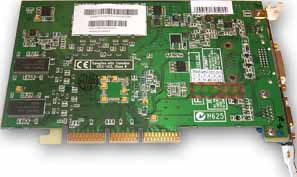 [an error occurred while processing this directive]
[an error occurred while processing this directive]
Both Joytech cards differ significantly from the ATI's reference card. It is also interesting that instead of the DVI-to-d-Sub adapter there is a VGA connector on a separate bracket with a cable for connection of CRT monitors:
[an error occurred while processing this directive] [an error occurred while processing this directive]
[an error occurred while processing this directive]
The other end of the cable is connected to the video card via the Feature Connector.
If you remember, the RADEON 7500 has two integrated high-frequency RAMDACs which allow using two monitors equally, and now image quality on the second monitor won't be too good.
The saddest thing is that the chip on both cards work at 200 MHz instead of 290 MHz like of the ATI cards or 270 MHz like of the cards from its partners with DDR memory. Well, you might think that it is a pure RADEON, but no - it is still a RADEON 7500!
[an error occurred while processing this directive] [an error occurred while processing this directive]
[an error occurred while processing this directive]
Well, why to install a 270 MHz chip if the memory will kill the performance anyway... At the same time Joytech helps ATI get rid of residues of production of the RADEON 7500. And Joytech benefits as it buys such chips for peanuts. Hence low production costs, and the cards are meant for the price niche less than $100. It should be noted however, that Joytech is going to increase a frequency of the RADEON 7500 up to 230 MHz though it won't help the performance much.
Below you can take a look at two "eye-washing" boxes:
[an error occurred while processing this directive] [an error occurred while processing this directive]
[an error occurred while processing this directive]
[an error occurred while processing this directive] [an error occurred while processing this directive]
[an error occurred while processing this directive]
Tell me now whether you will be able to tell a normal RADEON 7500 card from such a crippled one judging by their boxes? I think it is ATI who should be blamed as it doesn't care about any separation of cards with different frequencies and with different memory types!
Well, coming back to the Joytech Apollo RADEON 7500 I'd like to ask you a question - what for such a crippled card needs 128 MBytes of slow memory? It just marketing...
The cards come with a CD with drivers from ATI, a sheet of paper with installation instructions and an S-Video extender.
Now if you are going to buy such video cards be careful and examine attentively what's inside before paying the money.
To justify such cards I want to say that the companies are just looking for ways to produce cheaper cards on the same chips. It is actually not bad as a user has a wider choice (either a normal RADEON 7500 for $150 or a crippled one for $100). I only wish there were proper information on the box.
Joytech Apollo 3D Thrill 315 128 MBytes
This card is based on the SIS 315 chip. The architecture of this chip is very similar to the NVIDIA Riva TNT2, but it also has a Hardware T&L unit. There are two pipelines with one texture unit on each which work in the single-pipeline mode in case of multiplexing. The memory bus is of 128bit. That is why it should operate at the level of the Riva TNT2 Pro or GeForce2 MX200.
As you understand this SIS 315 based card doesn't need 128 MBytes SDR memory at all. However, when installation of such RAM doesn't affect the cost much the marketing plays again a great role.
The Joytech Apollo 3D Thrill 315 128 MBytes card has an AGP x2/x4 interface, 128 MBytes SDR SDRAM located in 8 chips on the right side of the PCB.
[an error occurred while processing this directive] [an error occurred while processing this directive]
[an error occurred while processing this directive]
[an error occurred while processing this directive] [an error occurred while processing this directive]
[an error occurred while processing this directive]
[an error occurred while processing this directive] [an error occurred while processing this directive]
[an error occurred while processing this directive]
V-Data produces memory chips with 6 ns access time which corresponds to 166 MHz. And the memory works at this frequency (it corresponds to the rated speed for the SIS 315 working at 166/166 MHZ).
The video card is based on the Joytech's proprietary design. That is why it considerably differs from the SIS's card:
Joytech Apollo 3D Thrill 315 128 MBytes
[an error occurred while processing this directive] [an error occurred while processing this directive]
[an error occurred while processing this directive]
[an error occurred while processing this directive] [an error occurred while processing this directive]
[an error occurred while processing this directive]
SIS 315 32 MBytes
[an error occurred while processing this directive] [an error occurred while processing this directive]
[an error occurred while processing this directive]
[an error occurred while processing this directive] [an error occurred while processing this directive]
[an error occurred while processing this directive]
Moreover, the Joytech card doesn't have SIS301 coprocessor which has a dual-monitor support. That is why you won't be able to use either an output to the second monitor or TV-out.
The cooler is also unusual:
[an error occurred while processing this directive] [an error occurred while processing this directive]
[an error occurred while processing this directive]
The video card ships in an OEM package.
Leadtek WinFast GeForce3 Ti200 TDH 128 MBytes
The Leadtek WinFast GeForce3 Ti200 TDH 128 MBytes has an AGP x2/x4 interface, 128 MBytes DDR SDRAM located in 8 chips on the right side of the PCB.
[an error occurred while processing this directive]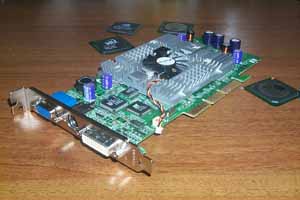 [an error occurred while processing this directive]
[an error occurred while processing this directive]
[an error occurred while processing this directive]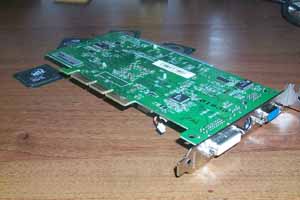 [an error occurred while processing this directive]
[an error occurred while processing this directive]
[an error occurred while processing this directive]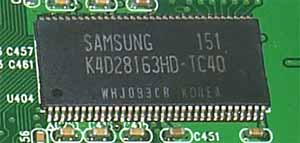 [an error occurred while processing this directive]
[an error occurred while processing this directive]
The memory chips are produced by Samsung and have a 4 ns access time which corresponds to 250 (500) MHz. According to the specifications, the memory works at 200 (400) MHz. As you can see the memory is faster than usual, that is why we can hope for a decent overclockability.
The card doesn't differ much from its 64 MBytes version. It is based on the reference design, though the Hardware Monitoring chip is mounted differently.
Leadtek WinFast GeForce3 Ti200 TDH 128 MBytes
[an error occurred while processing this directive] [an error occurred while processing this directive]
[an error occurred while processing this directive]
[an error occurred while processing this directive]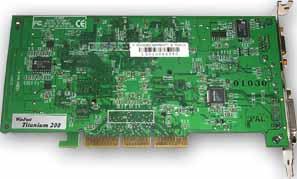 [an error occurred while processing this directive]
[an error occurred while processing this directive]
NVIDIA GeForce3 Ti 200 reference card
[an error occurred while processing this directive]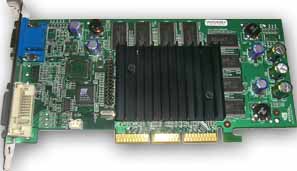 [an error occurred while processing this directive]
[an error occurred while processing this directive]
[an error occurred while processing this directive]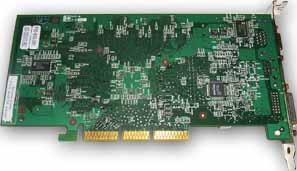 [an error occurred while processing this directive]
[an error occurred while processing this directive]
I must say that the first lots of 64 MBytes cards on the Ti200 were based on usual GeForce3 cards and were equipped with a 3.8ns memory. But they are not available anymore.
The bright green PCB has a huge silvery cooler which is a single heatsink for the memory and chip. Under the heatsink there is a graphics processor (now the label Ti 200 is marked on the chip's lid):
[an error occurred while processing this directive] [an error occurred while processing this directive]
[an error occurred while processing this directive]
On the left there is a thermo sensor as such cards from Leadtek support thermo control monitoring.
The Leadtek WinFast GeForce3 Ti200 TDH 128 MBytes is equipped both with TV-out and DVI.
[an error occurred while processing this directive]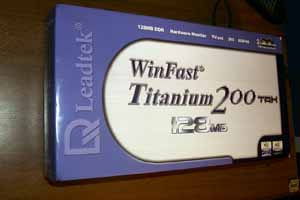 [an error occurred while processing this directive]
[an error occurred while processing this directive]
The card ships in a Retail package which contains the following accessories:
Overclocking
The Leadtek WinFast GeForce3 Ti200 TDH 128 MBytes has an excellent overclocking potential as it was able to reach 225/250 (500) MHz.
Note:
[an error occurred while processing this directive] [an error occurred while processing this directive]
[an error occurred while processing this directive]
Test system and drivers
Test system configuration:
In the tests we used NVIDIA's drivers v21.85, ATI's drivers v9.008 and SIS's ones v2.03.00. VSync was off, S3TC was activated.
For the comparative analyses we used the following cards:
Test results
2D quality was excellent in case of the Leadtek WinFast GeForce3 Ti 200 TDH card. There were no artifacts even in 1600x1200 at 85 Hz. The RADEON 7500 cards from Joytech had worse quality, in the same resolution the acceptable level was provided only at 75 Hz. The SIS315 video card has more modest results, though it flawlessly operates in 1280x1024 at 75 Hz.
For estimation of 3D quality we used:
Quake3 Arena
Quaver, Highest Quality Mode
The tests were carried out in 32bit color modes with the maximum detailing level of textures and geometry (r_subdivisions "1" r_lodCurveError "30000"). This benchmark loads accelerators with complicated geometry as well as with huge textures and a great deal of effects.
Low-end sector
[an error occurred while processing this directive] [an error occurred while processing this directive]
[an error occurred while processing this directive]
[an error occurred while processing this directive] [an error occurred while processing this directive]
[an error occurred while processing this directive]
The SIS315 card looks quite strange in 1024x768 at 32-bit color: it slows down from time to time. Even in 1280x1024x32 the speed then gets higher.
On the whole, its speed is higher than that of the GeForce2 MX200 (128 MBytes helped a little). That is why if 32 MBytes and 128 MBytes versions won't differ much in prices it is better to go with the latter, especially considering that quality of the Joytech cards is rather high.
Middle-end sector
[an error occurred while processing this directive] [an error occurred while processing this directive]
[an error occurred while processing this directive]
[an error occurred while processing this directive] [an error occurred while processing this directive]
[an error occurred while processing this directive]
The RADEON 7500 doesn't benefit at all from the 128 MBytes memory. The cards incorporate normal RADEON 7500 which is able to work almost at its rated speed (the PowerStrip didn't let higher than 266 MHz, but more is needless as the performance is limited by the memory bandwidth). And where it was possible to overclock the memory together with the GPU the performance gain from overclocking is noticeable. There is nothing similar in case of the 128 MBytes although the chip was overclocked by 66 MHz!
Look how much these cards fall behind from the normal RADEON 7500! The GeForce2 MX400 card shows a little worse results, almost at the level of the Joytech Apollo RADEON 7500 SDR.
High-end sector
[an error occurred while processing this directive] [an error occurred while processing this directive]
[an error occurred while processing this directive]
Again we see that 128 MBytes of RAM do not help the Ti 200 to lift the performance. That is why you can buy such cards only for future games where texture sizes will be even greater.
In closing I'd like to recommend you to read our 3Digest in the next issue of which we will include the today's cards.
Conclusion